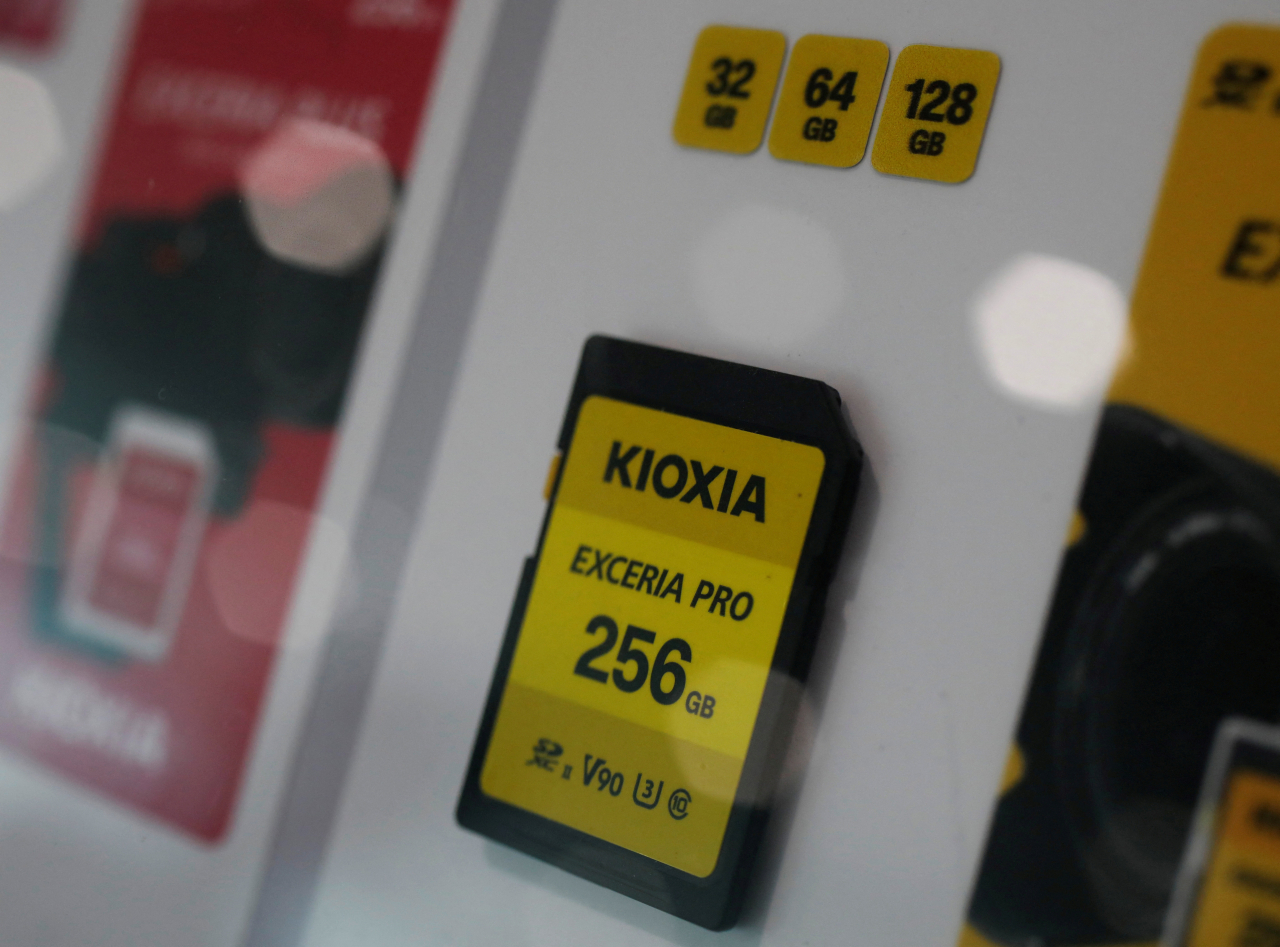Market Now
Kioxia-Western Digital merger talks no immediate threat to Samsung, SK
 |
Japanese chipmaker Kioxia's product is displayed at its headquarters in Tokyo on Sept. 30, 2021. (Reuters-Yonhap) |
As the world's No. 2 and No. 4 NAND flash suppliers of Japan and the United States are discussing a potential merger to achieve market prowess, eyes are on how the move will impact the current market leader Samsung Electronics.
In a report last week, Reuters said Japan's Kioxia Holdings and the US' Western Digital -- ranked the world's second- and fourth- biggest memory chip makers, respectively -- are reportedly in talks for a merger, renewing their previous discussion from 2021.
Under the plan being drafted, Kioxia will take 43 percent of the shares of the merged entity while Western Digital will own 37 percent, according to sources cited by the news agency. The rest will be owned by existing shareholders of the companies.
Amid a severe downturn in the global chip industry, the potential merger of the two market leaders is raising questions on the impact it will have on South Korea's two memory chipmakers Samsung Electronics and SK Group, who currently stand at No. 1 and No. 3 in the market, respectively.
According to the market analysis firm TrendForce, Samsung Electronics topped global sales of NAND flash chips in 2022, taking the market share of 33.3 percent, while Kioxia followed at 18.9 percent. SK hynix, combining the sales of its affiliate Solidigm, ranked third, taking 18.3 percent of market share, while Western Digital posted 12.7 percent.
In the event of a Kioxia-Western Digital merger, their combined market share of 31.6 percent would beat that of SK hynix, and follow closely on the heels of Samsung.
For the Korean firms, opinions are mixed over the merger. Having to compete against a bigger merged entity could create pressure, but it could also play out to reduce the competition, experts here say.
Song Myung-sub, an analyst at Hi Investment and Securities, said it could work in Korean firms' favor, reducing the number of competitors from the current four to three.
“Now, Kioxia and Western Digital are making investments as two separate companies, but when they merge, the investment volume for equipment could decrease,” Song said.
At the same time, Korean companies have an upper hand in technology and are less likely to be influenced by the merger, industry watchers say.
“When combined, the market share of Kioxia and Western Digital would follow closely on Samsung's heels. But considering the companies’ production capacity and financial performance, their merger would not have such an impact to shake Korean memory chipmakers,” an industry official said under the condition of anonymity.
As memory chip makers compete to increase layer counts, Samsung kicked off mass-production of 236-layer NAND flash memory -- the industry's current top capacity. The tech giant also plans to develop a 1000-layer V-NAND by 2030.
SK hynix is also expected beat the layer count of Samsung to start the mass production of a 238-layer NAND flash within this year.
The Japanese and American chipmakers, on the other hand, face difficulties in mass producing NAND flash chips with layers of over 200.
According to Reuters, the drive for the merger comes amid efforts by Western Digital to spinoff its split memory business from its hard drive division. Since making an initial stock investment in 2022, Elliott Management, the activist investor owning convertible preferred shares in the American chipmaker, has been pushing for the spinoff.
At the same time, Kioxia and Western Digital appear to be seeking to join forces after their initial attempt failed in 2021, as they continue to face losses in operating income. In the January-March period this year, Kioxia logged an operating loss of 171.4 billion yen ($1.24 billion), while Western Digital witnessed a loss of $470 million.
However, even if the two companies reach a deal, it would likely draw antitrust scrutiny in several countries including the United States and China.
By Jo He-rim (herim@heraldcorp.com)


![[Global Finance Awards] Mirae Asset Securities' global top-tier ambition within reach](http://res.heraldm.com/phpwas/restmb_idxmake.php?idx=151&simg=/content/image/2024/11/27/20241127050077_0.jpg)
![[Global Finance Awards] Kyobo Life enhances insurance coverage for cancer, long-term care](http://res.heraldm.com/phpwas/restmb_idxmake.php?idx=151&simg=/content/image/2024/11/26/20241126050106_0.jpg)
![[Global Finance Awards] Kakao Bank bolsters SE Asia foray with Superbank partnership](http://res.heraldm.com/phpwas/restmb_idxmake.php?idx=151&simg=/content/image/2024/11/27/20241127050076_0.jpg)
![[Global Finance Awards] IBK boosts support for small businesses](http://res.heraldm.com/phpwas/restmb_idxmake.php?idx=151&simg=/content/image/2024/11/27/20241127050072_0.jpg)
![[Global Finance Awards] Shinhan chief pushes to boost corporate value](http://res.heraldm.com/phpwas/restmb_idxmake.php?idx=151&simg=/content/image/2024/11/27/20241127050074_0.jpg)
![[Global Finance Awards] Mirae Asset bolsters global presence with W370tr under management](http://res.heraldm.com/phpwas/restmb_idxmake.php?idx=151&simg=/content/image/2024/11/27/20241127050075_0.jpg)
